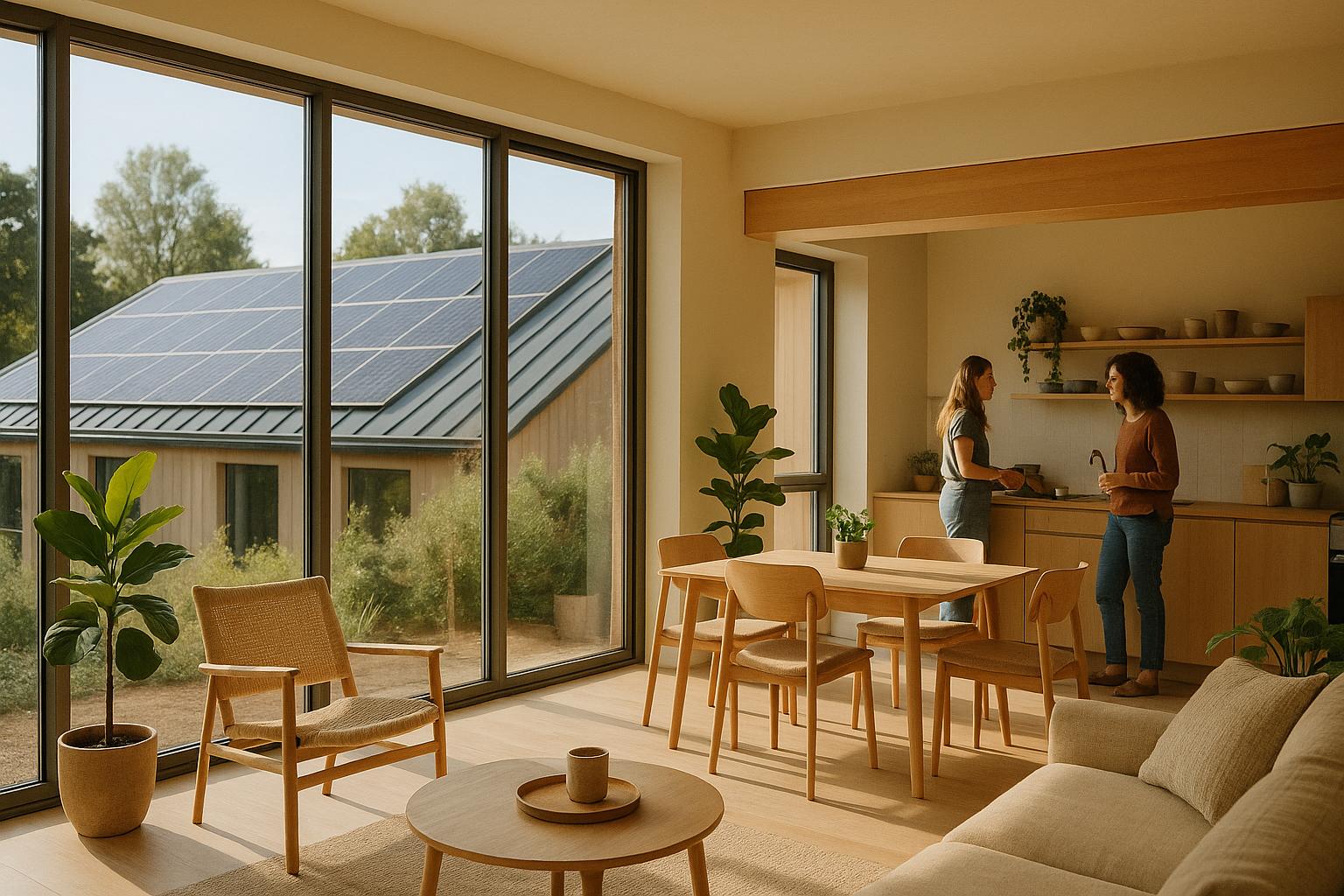Shared living helps cut down on energy use, waste, and emissions by pooling resources and sharing spaces. Instead of each person maintaining separate systems like heating, cooling, or appliances, shared living combines these needs, saving energy and reducing costs. Residents often share transportation, tools, and supplies, further lowering their environmental impact. Many shared spaces also include efficient appliances and systems that reduce energy waste.
Key benefits include:
- Lower energy use: Shared utilities and appliances consume less per person.
- Less waste: Shared resources and bulk purchasing reduce packaging and trash.
- Reduced transportation emissions: Carpooling, public transit, and shared vehicles are easier to use.
This living arrangement not only reduces your carbon footprint but also makes eco-friendly practices more practical and affordable.
The Environmental Cost of Regular Housing
When you take a closer look at traditional housing, it’s easy to see why shared living can be a more eco-friendly option. Single-family homes tend to use resources inefficiently. Since these homes are designed to function independently, they require separate energy systems and utilities, which could otherwise be streamlined in shared living setups. This inefficiency drives up energy consumption and, in turn, increases the carbon footprint. Recognizing these issues underscores the environmental advantages of shared living.
Carbon Emissions from Home Energy Use
Traditional homes rely on individual systems for heating, cooling, and appliances. This setup means each home operates its own energy infrastructure, leading to greater energy consumption and higher carbon emissions compared to shared systems.
Waste Production and Resource Inefficiency
Energy isn’t the only concern. Regular housing significantly contributes to waste production. Back in 2018, U.S. households generated a staggering 292.4 million tons of waste - about 4.9 pounds per person every day[1]. Out of this, around 62% ended up in landfills or was burned[1]. This “use and discard” approach not only wastes resources but also squanders the energy used to produce them.
Suburban living adds another layer to this issue. It encourages reliance on personal vehicles, which means more roads, garages, and parking spaces are needed. This type of infrastructure amplifies the environmental burden even further.
How Shared Living Cuts Carbon Footprint
Shared living reduces individual environmental impact by making better use of resources and infrastructure, all while maintaining a comfortable lifestyle.
Shared Utilities Save Energy
When utilities like heating, cooling, and water systems are shared, they operate more efficiently than individual setups. These systems, designed for continuous use, optimize energy output and reduce per-person energy consumption.
The benefits go beyond just splitting utility bills. Shared living spaces often include energy-efficient appliances and systems because the higher usage justifies investing in advanced equipment. This means less energy wasted and more sustainable living overall.
Transportation is another area where shared living makes a big difference.
Group Transportation Options
Transportation is the largest contributor to carbon emissions worldwide, but shared living naturally promotes greener choices. For instance, living without a car can cut an individual’s annual carbon footprint by up to 3.6 tons[1]. Many shared living communities are located near public transit hubs, making it easier to go car-free. And when a car is needed, shared electric vehicle services offer a low-emission solution.
Carpooling and public transit also help. Carpooling can reduce emissions by up to 1.0 ton annually, while public transit cuts up to 2.2 tons. Shared mobility programs, such as bike-share and scooter-share services, become even more practical in these communities. Residents can split membership costs or coordinate use, maximizing efficiency and reducing the need for manufacturing new vehicles.
Energy-Saving Features in Coliving Spaces
Modern shared living spaces often include design features that save energy, features that might not be affordable in a single-person home. For example, coliving kitchens and laundry facilities frequently use ENERGY STAR certified appliances, which run 10–50% more efficiently than standard models. A shared ENERGY STAR washing machine, for instance, is far more efficient than multiple individual machines.
These spaces also tend to have better insulation and energy-efficient windows, which help maintain comfortable indoor temperatures year-round while reducing energy consumption.
Reducing Waste Through Shared Resources
Shared living doesn’t just save energy - it also cuts down on waste. Coordinated bulk purchasing reduces packaging waste compared to buying smaller, individual portions. For instance, a shared 25-pound bag of rice produces much less packaging waste than several 5-pound bags.
Shared kitchens help reduce food waste, too. Residents can plan meals together, avoid buying duplicate items, and prevent food from expiring unused. Community composting systems also thrive in shared living environments, as the combined organic waste from multiple people creates the perfect conditions for composting.
Additionally, sharing tools, cleaning supplies, and household items means fewer duplicate purchases. This reduces packaging waste and minimizes the environmental impact of frequent shopping trips. It’s a win-win for both the planet and your wallet.
Using Eco-Friendly Practices in Shared Living Spaces
Living with others can make adopting eco-friendly habits easier and more cost-effective. By working together, housemates can create routines that reduce their collective impact on the planet. Here are some practical ways to bring sustainable living into your shared space.
Planning Group Grocery Shopping
Instead of making individual trips to the store, organize group grocery shopping. This reduces transportation emissions and cuts down on packaging waste.
Start by setting up a shared grocery list - digital tools like apps can make this simple. Rotate shopping duties among housemates, with one or two people handling the task each week. Coordinate meals to use overlapping ingredients, which helps minimize food waste and keeps costs down.
Creating Recycling and Composting Systems
Streamlining waste management is key to eco-friendly living. Set up clearly labeled bins for recycling different materials like paper, plastic, glass, and metal. For organic waste, establish a composting system.
If you have outdoor space, create a compost area using bins or enclosures. For indoor setups, a worm bin can handle kitchen scraps efficiently without causing odors. Composting works especially well in shared spaces, as the combined organic waste can maintain a healthy composting system.
Making Community Rules for Eco-Friendly Living
Set house rules to manage energy and resources responsibly. Agree on basics like turning off lights when leaving a room, unplugging devices not in use, and running appliances only when full.
To save energy, schedule tasks like laundry or dishwashing during off-peak hours. Posting a schedule in common areas can help everyone stay on the same page. For heating and cooling, establish temperature guidelines that balance energy efficiency with comfort.
Consider adding an accountability element to keep everyone engaged. For example, you could set up a point system where housemates earn rewards for eco-friendly actions like biking to work or composting regularly. Alternatively, hold monthly meetings to review progress and brainstorm improvements.
Shared Living vs Regular Housing: Benefits for the Environment
Choosing shared living over traditional housing can significantly cut down on your environmental footprint. By pooling resources like utilities, appliances, and shared spaces, shared living maximizes efficiency. For example, instead of multiple kitchens, living rooms, and workspaces spread across individual homes, shared spaces serve everyone. This reduces energy use for heating, cooling, and lighting, especially in properties where many rooms in traditional homes often go unused.
Shared utilities and coordinated transportation options further reduce energy consumption and emissions. Purpose-built coliving spaces also take advantage of smart, energy-efficient designs. To better understand the environmental advantages, let’s break it down with a comparison of key metrics.
Key Metrics Comparison
Here’s how shared living stacks up against regular housing in terms of sustainability:
| Metric | Shared Living | Regular Housing |
|---|---|---|
| Energy Use | Lower per-person consumption due to shared systems | Higher, as each household uses separate resources |
| Water Consumption | More efficient with communal facilities | Higher with individual usage patterns |
| Space Utilization | Optimized with shared and multi-use areas | Often includes unused or underutilized spaces |
| Utility Costs | Lower for residents due to shared expenses | Fully borne by individual households |
| Carbon Emissions | Reduced through efficient resource use | Higher because of duplicated systems and resources |
This comparison highlights how shared living goes beyond being a housing choice - it actively promotes a more sustainable lifestyle by cutting resource waste and minimizing environmental impact.
Conclusion: Choose Shared Living for a Greener Future
Opting for shared living is a practical way to contribute to a more sustainable future. By embracing shared resources and communal practices, you can cut down on resource consumption and emissions while adopting a lifestyle rooted in environmental responsibility. This approach not only reduces individual carbon footprints but also nurtures a community focused on sustainable living.
Shared living also makes eco-conscious choices more affordable. With shared utility costs and reduced overall expenses, it’s easier to prioritize green living without sacrificing comfort or convenience.
The collaborative nature of shared living encourages sustainable habits. From group grocery shopping and shared appliances to community recycling efforts, these practices naturally develop within a communal environment, fostering collective accountability for reducing waste and conserving energy.
With over 2,000 coliving spaces spread across 400 cities worldwide, finding a sustainable housing option that aligns with your lifestyle is more accessible than ever. Every space chosen is a step toward minimizing resource use and strengthening environmentally aware communities.
Shared living is more than just a housing choice - it’s a meaningful way to lower your carbon footprint while connecting with others who share your commitment to sustainability. Together, you can create a greener, more connected future.
FAQs
How does shared living help lower your carbon footprint compared to traditional housing?
How Shared Living Reduces Your Carbon Footprint
Shared living is a smart way to minimize your environmental impact by making better use of resources and cutting down on waste. When people share utilities like electricity, water, and heating, the energy used per person drops significantly. Plus, having communal spaces reduces the need for multiple appliances or separate heating and cooling systems, which translates to lower energy consumption overall.
Many shared living setups also embrace eco-conscious features, such as energy-efficient designs, and encourage habits like carpooling or bike-sharing. These practices help lower vehicle emissions and promote a more sustainable way of life. Together, these efforts make shared living an effective choice for those looking to live in a way that's kinder to the planet.
How can I adopt eco-friendly habits while living in a shared space?
Living in a shared space while making eco-conscious choices is simpler than it sounds. Start by agreeing on some basic ground rules with your housemates for things like recycling, composting, and cutting down on waste. For example, you can avoid single-use plastics or limit items with excessive packaging.
Another easy way to make a difference is by conserving water. Simple habits like taking shorter showers or only running the dishwasher and washing machine with full loads can go a long way.
Sharing resources is another smart move. Whether it’s appliances, tools, or even transportation - like carpooling or using shared bikes - these actions reduce waste and energy use. Whenever possible, choose eco-friendly cleaning supplies and energy-efficient appliances. These small, shared steps don’t just help the planet - they also make your home a more balanced, enjoyable place to live.
What are some sustainability challenges in shared living, and how can they be managed?
Shared living isn’t without its challenges, especially when it comes to sustainability. Issues like uneven contributions to shared expenses, inconsistent recycling practices, or wasted resources can crop up if everyone isn’t on the same page about eco-friendly habits. For instance, without clear rules, some residents might neglect energy-saving measures, while others make an effort.
The good news? These hurdles are manageable. Setting clear guidelines for using shared resources can go a long way. You can also encourage group investments in things like energy-efficient appliances, which benefit everyone. Most importantly, fostering open communication and a sense of shared responsibility can help create a more environmentally conscious household. Small steps like these can lead to a noticeable reduction in waste and energy use.






